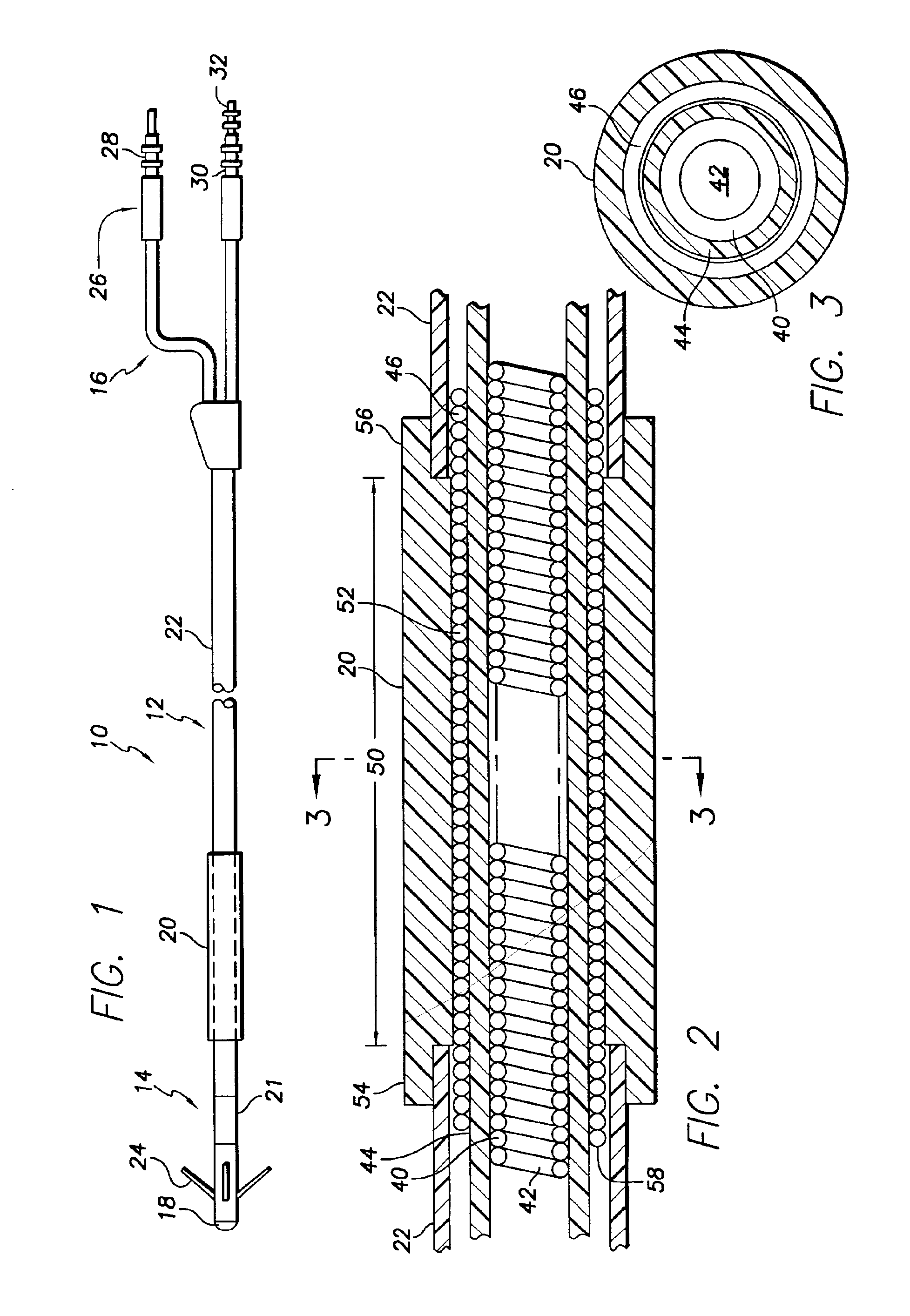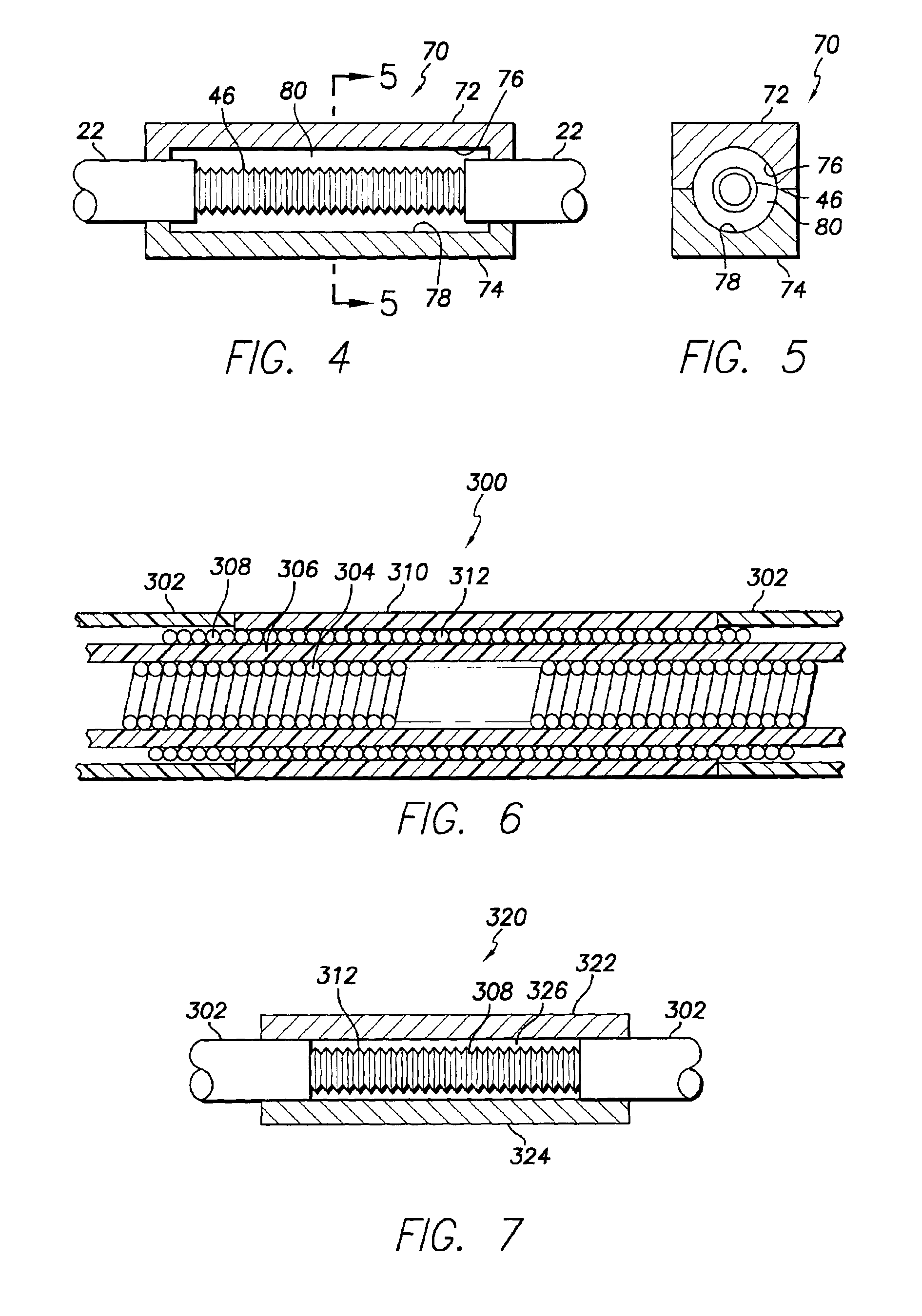Body implantable lead including one or more conductive polymer electrodes and methods for fabricating same
a technology of conductive polymer and implantable leads, which is applied in the field of body implantable, transvenous leads having one or more conductive polymer electrodes, can solve the problems of affecting interpretation, posing potentially serious risks to patients, and unable to provide sufficient charge/current to effectively and reliably terminate defibrillation
- Summary
- Abstract
- Description
- Claims
- Application Information
AI Technical Summary
Benefits of technology
Problems solved by technology
Method used
Image
Examples
first embodiment
[0057]FIG. 1 shows in simplified, schematic form a passive-fixation endocardial, body implantable lead 10 in accordance with the invention. The lead 10 includes a lead body 12 having a distal end portion 14 and a proximal end portion 16. The distal end portion 14 includes a tip electrode 18 and a conductive polymer cardioversion / defibrillating shocking electrode 20, hereinafter sometimes referred to simply as a defibrillating electrode. By way of example and not limitation, the distal end portion 14 of the lead body 12 may have a diameter of about 0.026 inch (2F) to about 0.131 inch (10F), with a diameter of about 0.079 (6F) being preferred, and the electrode 20 may have a diameter of about 0.091 inch (7F) and a length of about 2 inches. As is well known in the art, a lead of the type shown may further include a sensing electrode 21 in the form of a ring positioned proximally of the tip electrode. Such a ring sensing electrode may have a length of, for example, about 0.100 inch. The...
second embodiment
[0067]FIG. 7 shows a compression mold 320 for forming in situ, the conductive polymer defibrillating electrode 310. The mold 320 is identical to the mold shown in FIGS. 4 and 5, including two mold parts 322 and 324 together defining an internal cylindrical cavity 326 within which the conductive polymer electrode 310 is formed. Pursuant to the invention, the cylindrical cavity 326 has a diameter equal to that of the tubular housing 302.
[0068]FIGS. 8 and 9 show a portion of a body implantable endocardial lead assembly 90 in accordance with a third embodiment of the present invention. As in the first embodiment, the lead assembly 90 is adapted to transmit electrical signals between a proximal end portion (not shown) and a distal end portion a part 92 of which is shown in FIG. 8. As before, the distal end portion includes a distal extremity including a tip electrode (not shown) adapted to engage cardiac tissue and to electrically stimulate that tissue and / or sense electrical stimuli the...
fifth embodiment
[0075]As in the case of the embodiment of FIG. 6, the trilumen lead body embodiment of FIGS. 8-11 may be provided with a conductive polymer defibrillating electrode that has the same outer diameter as that of the lead housing. In this connection, FIGS. 13 and 14 show the invention comprising a lead body 370 including a trilumen housing 372 having a window 374 for exposing uninsulated lengths of one or more cable conductors 376 about which a conductive polymer electrode 378 is molded. To achieve the isodiametric structure desired, the outer diameter of the housing 372 is reduced at 380, that is, along the window 374. As before, a 2-part compression mold 382 (FIGS. 15 and 16) is preferably used to fabricate the conductive polymer electrode 378.
[0076]FIGS. 8-16 illustrate leads in accordance with the present invention that in each case comprises a multilumen housing including a pair of redundant cables (or small diameter, finely wound coils) electrically connecting a conductive polymer...
PUM
 Login to View More
Login to View More Abstract
Description
Claims
Application Information
 Login to View More
Login to View More - R&D
- Intellectual Property
- Life Sciences
- Materials
- Tech Scout
- Unparalleled Data Quality
- Higher Quality Content
- 60% Fewer Hallucinations
Browse by: Latest US Patents, China's latest patents, Technical Efficacy Thesaurus, Application Domain, Technology Topic, Popular Technical Reports.
© 2025 PatSnap. All rights reserved.Legal|Privacy policy|Modern Slavery Act Transparency Statement|Sitemap|About US| Contact US: help@patsnap.com



